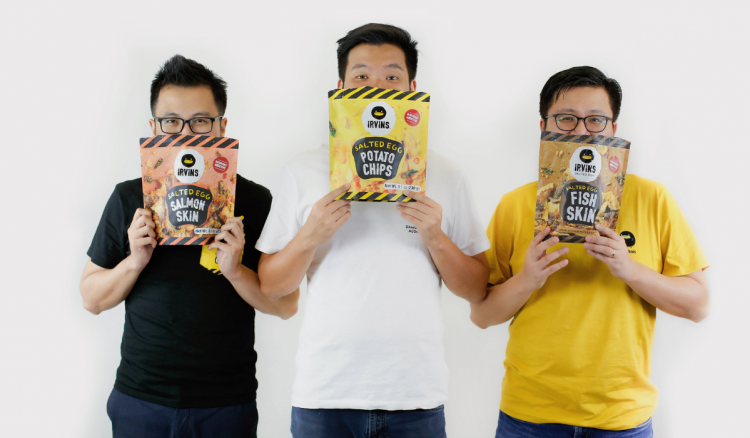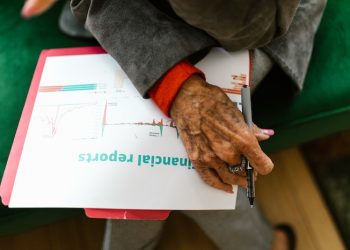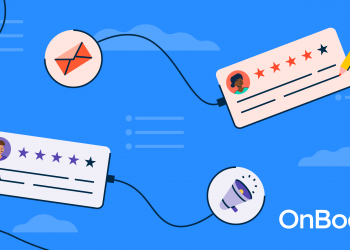Irvin Gunawan is the founder and CEO of IRVINS, the creator of Singapore’s #1 salted egg snack. IRVINS is a high-growth homegrown consumer food brand expanding quickly on the global stage, with 5 offices and 12 markets worldwide and a product lineup that redefines the food industry.
Singaporean cuisine and flavors are becoming popular globally, and IRVINS is the leading snack brand that celebrates salted eggs, the “parmesan of Asia” that most have never heard of. We caught up with Irvin to ask about the global snack brand’s humble beginnings, why quality is so important for CPG food products, and their marketing strategies for entering the US.
Q&A with Irvin Gunawan, Founder of IRVINS
Q: Irvin, first off, what’s it like to run a business with your brothers?
A: My big brother, Ivan, runs our commercial and finance; my younger brother, Ircahn, runs our operations, including the factory and supply chain, and I take care of the product and business development. It’s been seven years and counting since they got involved in running IRVINS. Certainly, patience and compassion are tested, but we have been strong and united–especially during the tough times. That’s an achievement we’re most proud of.
Earlier in my career at IRVINS, I assumed any good person could fit any gap that needed filling. In hindsight, I wasn’t focused on matching the individual with the right skill set to the right role.
Many young founders make the mistake of assigning roles to close friends or family members based on trust, but it’s not always the right solution. For that reason, my brothers and I divvy up roles and responsibilities based on our specific talents and skills.
Q: Tell us how you started your business almost by “mistake?”
A: I owned and operated a successful seafood restaurant in the heart of Singapore. We were famous for our Salted Egg Crab. We were running a successful business until one day, our landlord suddenly terminated our lease.
So we had to hustle and move quickly–but we had to relocate to an undesirable, less central/residential area. There was almost zero foot traffic, and so we had to get creative. I brainstormed ways we could create revenue streams, so we didn’t have to rely solely on sit-down diners–and this was pre-pandemic!
So I asked my head chef to dream up a snack featuring salted eggs that we could sell at the front of the restaurant. That’s how our Salted Egg Salmon Skin and potato chips were born. To my knowledge, salted egg chips didn’t exist before.
What I thought would bring in a little bit more money to help us stay afloat while I figured out the next move turned into an overnight success.
There were lines wrapped around the block, and I had to limit the number of bags people could purchase until I figured out how to increase production. I ultimately made the hard decision to close IRVINS the restaurant and focus on IRVINS the snack brand.
I needed help getting it off the ground and brought in my two brothers, Ivan and Ircahn, to operate the business with me. Ircahn drew the floorplan of our first two factories on tissue paper, and in the beginning we would all take turns delivering products ourselves, averaging 10-15 addresses per day (orders from our website), while the other would run the kiosk pop-ups. We finally opened our first official retail store in 2016.
Q: When did you know that you had a market in the US? How did you approach your growth strategy?
A: Good product. Good locations. Good friends. Good food. Our stores in Singapore, especially our airport locations, really helped us raise awareness in the US. Additionally, my brother Ircahn went to college at USC (University of Southern California) and made a lot of friends there who, once they discovered IRVINS, would tell us they’d buy our products in bulk when they visited Singapore to share with friends and family (who loved them!).
So it was a combination of strategic retail locations overseas, word of mouth from friends and fans, and the unique flavor of our gourmet snacks that allowed us to hit the ground running in the US.
When we officially launched there in 2020, our salted egg snacks were already popular among Asian American communities before we had even spent one dollar on advertising!
Upon landing in the US and selling out at various markets within days, we realized we had to work with a distributor to get bigger. We didn’t know what we didn’t know. So we hired two distributors–one on the West Coast and one on the East Coast–to sell our products through ethnic Asian markets, including Ranch 99 and H Mart. We also worked with a network of Asian influencers in Los Angeles as a strategic partnership to spread awareness.
In the last year, we’ve been in Costco stores across the US (and counting), and that has helped us break out of the “only” Asian American market and into the mainstream. We’re the only salted egg snack offered there, and it’s an amazing opportunity for us.
Q: Product development for food offers a wide range of challenges and opportunities. What advice would you give to CPG startups looking to develop a product?
A: Generally, food and drink product development takes a long time–anywhere from 9 to 18 months–so you have to plan for that from the start. My rule of thumb is to assume it will take a lot longer than you think. In other words, plan for the worst and hope for the best.
We’ve tried all kinds of methods to try to outsmart the process. For instance, we’ve tried the quantity over quality approach (once we tried to launch six products every quarter), have done a lot of collaborations, and even created a restaurant arm for quicker testing. We found, however, that the best way to develop not just a good but a great product is to be laser-focused on quality and flavor and on being great at the things you have real expertise in.
In IRVINS’ case, it’s the salted egg flavor. We take pride in the whole food ingredients, recipe, and cooking process. So much so that we are unwilling to cut corners because having to do something all over again because it’s almost always a recipe for failure.
Additionally, for CPG startups, I strongly believe in the power of creating an innovative white space product rather than repurposing what is currently on-trend because trends change, and you don’t want to be a one-hit-wonder.
Q: How do you decide when to add a new product to your catalog?
A: We only add new products when the demand can drive the ROI. This could be from our current customers or from retailers who are clued into what their shoppers want.
Before we take the plunge, however, we carefully evaluate whether the new product would be differentiated enough from our lineup to make the investment worth it. An example is our Smoked Cheese Salmon Skin.
We wanted to provide a more familiar flavor for a more mainstream audience. It has been our most popular new flavor launch in Asia so far, and we are gearing up to bring it to our first US retail location, a Holiday Pop-Up in LA’s Westfield Century City, which opens in early November and runs through February 2023.
Q: How do you balance your retail and direct-to-consumer strategy? Is one more effective than the other?
A: While DTC is our primary focus via eatirvins.com, pop-ups allow us to better control the customer experience, sell our expanded range of products, and engage with customers more thoughtfully and intentionally.
Almost nothing beats in-person sampling and real-time feedback. Retail wins the distribution game but offers much fewer customer connection opportunities. Therefore the two are complementary and should be pursued together at all costs.
Q: Why have you maintained your production location in Singapore?
A: Being in Singapore allows us to be close to the ingredient source and to maintain freshness while minimizing cost and more cleanly navigating logistics. For instance, we source our salmon skins, salted egg, fresh chilis, and curry leaves from Southeast Asia.
Secondly, I am very comfortable and involved with our quality control process in Singapore, including how we access the best ingredients, our skilled manpower, and the management team who are able to closely monitor production. We have a BRCGS (one of the highest global food safety standards as required by Costco) certified factory here in Singapore, so our customers can be confident in the quality of the products we are selling.
Finally, the way we produce our products in our factories is still the same way we produced them in our restaurants years ago, through a lengthy manual and labor-intensive process and using real natural ingredients.
This handmade, time-intensive cooking process makes our quality a big differentiator, and it is challenging to find a co-packer who has such capabilities.
Q: How did you discover the market for a salmon skin product?
A: We were making Salted Egg Dory Skin in Asia, which was very popular. When we decided it was time to expand to the US we learned that Dory was not allowed to be sold in the US, so we had to pivot fast.
Salmon and salmon skin is known for its many health benefits and rich flavor, and upon researching options, we realized nobody was making salmon skin chips – at least on a commercial level. So, we decided to change that.
We found a couple of well-respected salmon suppliers and asked if they’d be interested in working with us. It was a no-brainer for them because it allowed an otherwise discarded part of the fish to be used, which led to an additional income stream for the fisherman. It’s the only salted egg product sold in Costco right now, and people love it!
Q: Your branding is fun and energetic. What went behind the development of the look and feel?
A: I wanted to communicate exactly what our salted egg salmon skin and potato chips are: colorful, bold, delicious, daring, different – and messy. We wanted to have some fun with the branding by merging all of those things together on the packaging, our website, social media, and our pop-ups so you have an idea of what you’ll get before even trying the snacks.
Q: What marketing tactic is working right now for IRVINS?
A: In the US, on-the-ground sampling is working very well. It’s why we are so focused on pop-ups and on sampling programs in supermarkets. We are still hard at work increasing awareness in the US of salted egg and salmon skin chips, so literally feeding their curiosity and letting them taste so they feel more comfortable making the purchase is crucial.
Read more: How Brad Charron “Refounded” Plant-Based Protein Brand ALOHA – Q&A
Q: What is the best piece of advice you’ve received?
A: The restaurant manager of Irvins Seafood restaurant 10 years ago told me to focus and think for the long term. This was exceptional advice, and I attribute the success of IRVINS today to doing just that. We continue to focus on what we do best, which is creating and experimenting with delicious salted egg dishes that we can share with the world.
Q: What is the worst piece of advice you’ve received?
A: I can’t remember any horrible ones. I’m lucky to be surrounded by good people!
Q: What one driver for growth for young CPG startups should focus on?
A: Don’t compromise on taste and quality–ever.
You have one shot at getting people to fall in love with your products, and it’s better to have 10 loyal fans than 100 people who tried it and didn’t love it.
And in the same vein, know who is making your products. I mean personally. Connect with every single one of them from the start to make sure they not only know what they’re doing but that they love the products as much as you do. And at the same time, go out and meet your customer. Shake their hands, figure out what their favorite foods and flavors are, let them know you care and treat all of them like a best friend.
Source by foundr.com











